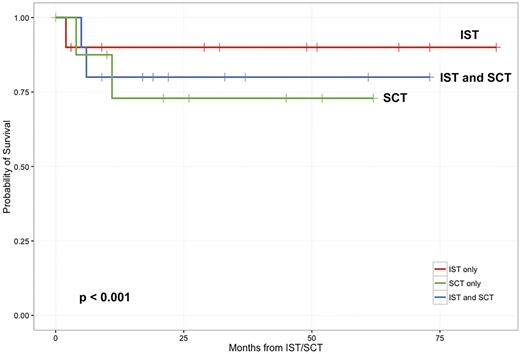Abstract
Background
Aplastic anemia (AA), characterized by bone marrow failure resulting in pancytopenia, is a rare condition with an incidence rate of 2-3 cases per million per year internationally(Montane et al., 2008). Treatment consists of immune-suppressive therapy (IST), hematopoietic stem cell transplantation (SCT), or both depending on patient factors such as age and comorbidities. Some studies suggest patients who received SCT from alternative transplant donor, specifically matched unrelated donor (MUD), may experience similar outcomes as the time-tested matched related donor (MRD)(Kennedy-Nasser et al., 2006, Buchholz et al., 2008). We compare the survivals of our patients under different treatments and further examine how transplant donor types affect outcomes.
Methods
We retrospectively retrieved the medical records of patients with the ICD-9 and ICD-10 code of aplastic anemia in their diagnosis seen at the University of Arizona Cancer Center/University Medical Center at Tucson, Arizona from 1990 to 2016. There are 104 patients returned with these search criteria. After chart review, patients who did not have aplastic anemia or with insufficient data for analysis were removed, leaving a total of 65 patients in the cohort. Survival analyses with 95% confidence intervals (CI) were estimated by Kaplan-Meier method and compared by log-rank test. P-values less than 0.05 were considered to be statistically significant. All statistical analyses were performed using R Statistical Software (Foundation for Statistical Computing, Vienna, Austria).
Results
A total of 65 patients were included in the study with 25 males (38%) and 40 female (62%). Median age at diagnosis was 22 years ranging from 1 to 64 years. Overall survival (OS) was 70%+/-7.2 (95% CI, 56.8-85.3). Patients were divided into 3 treatment categories including those who had received IST only (13/65, 20%), transplant only (41/65, 63%), and combination (11/65, 17%). OS for each category was 92%+/-7.4, 64%+/-8.5, and 82%+/-11.6, respectively as shown in Figure1A(p=0.321). Applying the same analysis on patients who had received treatment in the last decade from 2007 and beyond showed improved outcomes for those who had received transplant only (9/29, 31%) with OS of 73%+/-17% as demonstrated in Figure1B(p<0.001). Further analysis by comparing OS in patients with various types of transplant donor including MRD (33/65, 51%), MUD (7/65, 11%), umbilical cord blood (UCB) (3/65, 5%), and mismatched (9/65, 14%) showed OS of 76%+/-9%, 71%+/-17%, 67%+/-27%, and 33%+/-16%, respectively as shown in Figure 2 (p=0.012). No significant correlations were found between the amount of CD34 transfused and survival.
Conclusions
Our findings suggest IST remains the treatment method with the highest OS for those who are eligible. Advances in supportive care during transplant period in the last decade translate to better outcomes for these patients. For those who are appropriate for SCT, MRD is the optimal donor choice.
References
BUCHHOLZ, S., DAMMANN, E., KOENECKE, C., STADLER, M., FRANZKE, A., BLASCZYK, R., BREMER, M., KRAUTER, J., HERTENSTEIN, B., GANSER, A. & EDER, M. 2008. Allogeneic stem cell transplantation from related and unrelated donors for aplastic anaemia in adults--a single-centre experience. Ann Hematol, 87, 551-6.
KENNEDY-NASSER, A. A., LEUNG, K. S., MAHAJAN, A., WEISS, H. L., ARCE, J. A., GOTTSCHALK, S., CARRUM, G., KHAN, S. P., HESLOP, H. E., BRENNER, M. K., BOLLARD, C. M. & KRANCE, R. A. 2006. Comparable outcomes of matched-related and alternative donor stem cell transplantation for pediatric severe aplastic anemia. Biol Blood Marrow Transplant, 12, 1277-84.
MONTANE, E., IBANEZ, L., VIDAL, X., BALLARIN, E., PUIG, R., GARCIA, N., LAPORTE, J. R., CATALAN GROUP FOR STUDY OF, A. & APLASTIC, A. 2008. Epidemiology of aplastic anemia: a prospective multicenter study. Haematologica, 93, 518-23.
Overall survival (n=65) in patients who had received immune-suppressive therapy (IST) only, hematopoietic stem cell transplantation (SCT) only, or both. B: OS (n=29) in patients with different types of treatment from year 2007 and beyond.
Overall survival (n=65) in patients who had received immune-suppressive therapy (IST) only, hematopoietic stem cell transplantation (SCT) only, or both. B: OS (n=29) in patients with different types of treatment from year 2007 and beyond.
Overall survival (n=65) in patients who had received immune-suppressive therapy (IST) only and hematopoietic stem cell transplantation (SCT) by different donor types including matched related donor (MRD), matched unrelated donor (MUD), umbilical cord blood (UCB), and others.
Overall survival (n=65) in patients who had received immune-suppressive therapy (IST) only and hematopoietic stem cell transplantation (SCT) by different donor types including matched related donor (MRD), matched unrelated donor (MUD), umbilical cord blood (UCB), and others.
Anwer:Seattle Genetics: Other: Advisory Board Participant; Incyte: Speakers Bureau.
Author notes
Asterisk with author names denotes non-ASH members.




